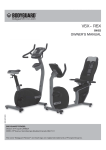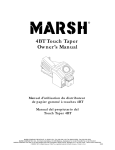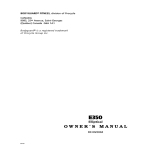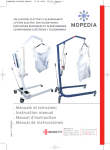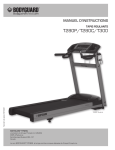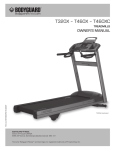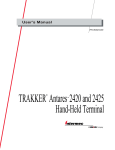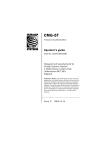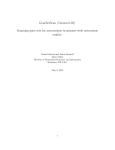Download 2012-14 T460XC-T560X Snap Shot
Transcript
! ! ! TREADMILL!MCB!CODE!SHEET! Model!#!F9621***!! ! ! ! Symbol Description Actions Relay Position Abnormal Usually accompanied by an Error 54 on the Display Change Motor Control Board Normal Operation – Relay is closed Don’t do anything! “Eight is Great” or “B is Beautiful” Default Position when Relay on MCB is open and waiting for instruction. Some errors cause the Relay to open, which then causes ‘C’ to appear on the MCB. If the unit is not operating and there is a ‘C’ on the MCB then there should be an error on the display if it has power. Speed Sensor Cable Error (Error 53 appears on the Display) ROM/PC Self Check error Elevation Motor Error Possibly Exceeding Range Note: After changing an MCB or an Elevation Motor an Elevation Calibration must be completed. ! ! Check that the speed sensor cable is connected to the MCB on the connector labeled “SPEED”. If not, attach it (Error C appears on the LED) and reset the treadmill. Check the speed sensor cable is not pinched. * If the Speed Sensor light flashes when you turn the motor but Error 53 still immediately appears when the treadmill is turned on it could be the R64 resistor on the MCB. EPROM is correctly installed but it self-tested the code and saw an error. Most likely solution is a new EPROM. Check the wire from the Elevation Motor is correctly plugged in at the connector labeled “INCLINE”. If it is not plugged in, the walking belt will run as normal but when the user tries to increase or decrease incline the value will change on the screen but the elevation will not move. If the wire is plugged in then Complete an Elevation Calibration to see if the problem is solved. If that doesn’t solve the problem, check the resistance in OHMS (between the black and white wires (not red) at the elevation connection) at the maximum elevation (should be 450 Ohms) and minimum elevation (850 Ohms) ! Revision!1.1!+!Dec.9.13! ! ! ! TREADMILL!MCB!CODE!SHEET! Model!#!F9621***!! ! ! ! Symbol Description Actions Check Elevation Motor power wires are connected Elevation Motor has a problem moving correctly on the MCB. If OK, then change the Elevation Motor. Motor Power Circuit problem Usually accompanied by an Error 52 on the Display Change Motor Control Board Data Cable or Safety Key issue If the Display has no power check if the Data Cable is connected correctly or damaged. If the Display has power, check if the Safety Key is installed and then try to start the treadmill. If “Please Put Safety Key” appears on the Display then check the Reed Switch wiring is connected correctly to the Display. If the wiring is connected correctly then check the Reed Switch is in the correct position inside the console within range of the safety key magnet. Check the reed switch is functioning correctly by testing continuity on the reed switch. The DC Voltage BUS is over its limit. 110V North American units should be 170 V DC so anything over 190 V DC causes an Error “U”. 220V International units should be 350 V DC so anything over 380 V DC causes an Error “U” First, Check the AC power into the machine, it should not exceed 125 V AC (N/A) or 240V AC (International) If the Power into the machine is OK then likely solution is to change the Motor Control Board. ! Revision!1.1!+!Dec.9.13! ! ! ! ! TREADMILL!DISPLAY!ERROR!CODES! Model!#!F9621****! ! ! Error Code - Description Actions PLEASE PUT SAFETY KEY Safety Key/Reed Switch Error Check if the Safety Key is correctly installed. Check if the cable from the Reed Switch is correctly connected to the Display Check if the Reed Switch is glued to the inside of the console and in the correct position so the safety key magnet activates the switch from the outside correctly. Check the Reed Switch (continuity) for a defect. Attach the safety key magnet to the switch and test. Note: If the Data Cable has been pinched (during installation/moving the treadmill) you can damage the Safety Key wire inside. The Safety Key error can occur if the other wires (power, ground and data transfer) were not damaged but the safety key wire was. Test the Data Cable for continuity or install a new data cable if you suspect this could have occurred. 51 Check if the Data Cable is connected to the MCB and Display correctly and the connectors are clean and clear of debris, especially the connection at the MCB, which can get dusty. If the connections are OK, then most of the time it is a problem with a pinched Data Cable that has Communication problem damaged one of the two communication wires inside (Data Transfer or Receive). Test the Data Cable between the Display and wires for continuity or install a new Data Cable to check. the Motor Control Board. Note: Data cables have 5 wires inside. 2 are for communication and if either of these are pinched then an Error 51 will appear on the Display assuming the power (12V DC) and Ground (Green) wires are not Tip: It is unlikely to have a damaged (if either of these are damaged the Display won’t light up as the circuit is open). The 5th wire good EPROM and a bad in the data cable is for the Safety key. MCB and get Error 51. Other Possibilities: Check the EPROM on the MCB as it could be inserted incorrectly (e.g. upside down) or it could have damaged pins. If the software is corrupted it will also produce Error 51. Less likely possibilities include a damaged MCB or a Display. 52 Tip: It is possible to get a Turn the treadmill off (reset treadmill), wait a few seconds and turn it on. If ERROR 52 does not appear False ERROR 52 on units on screen, it is a false ERROR 52 caused by a glitch in the MCB software. A software update is manufactured BEFORE required as it CAN NOT be done via EPROM. Therefore order a new MCB with the software preFeb, 2013 due to a software installed. If the Error 52 is still on screen then move onto the next suggestions. error. Revision!1.1!+!Dec!5,13! ! Error Code Description Actions Check the motor wires (+ & -) are correctly attached to the MCB. Test. On units manufactured before Feb, 2013, Error 52 could be caused by an Open Circuit detected from the Motor on the MCB (called Error 57 on units built after Feb, 2013) or a short circuit on the MCB. Check if there is a P on the MCB’s LED window. If so this confirms a short. 52 Quick Motor Functionality Test using a 9V Battery: Remove the Drive Belt that is connected to the Drive Motor Pulley so the motor can turn easily. Remove the Motor Wires and connect a 9V battery to the positive and negative connectors. When the motor wires make contact with the battery terminals the motor should spin. Thorough Motor Test: Place a multimeter pin in each motor wire connector and check the resistance. You should get a reading between 0.9 & 1.6 OHMS. If you get a slightly lower or higher reading then turn the flywheel a small amount and test again. A slightly higher or lower reading can be caused if the reading was taken between poles (e.g. lower than 0.9 or up to 4 ohms). If you get “OL” (Overload) on the multimeter then you have an open circuit in the motor and will likely have it in every position you try to take a reading. The above-mentioned Quick Motor Functionality Test would fail if you have an open circuit. You need to confirm if the “OL” is being caused by the Motor Brushes not making contact with the commutator or an error inside the motor. Check the Motor Brushes are making good contact with the commutator then it is possible that the circuit has been opened inside the motor causing the “OL” which requires a motor change. Note: YOU MUST complete a thorough Motor Test to see if it is If you get a correct reading between 0.9 and 1.6 Ohms with the 1st reading then continue to test the damaged and causing the motor in 11 more position. Rotate the motor flywheel (e.g. from 12 o-clock to 1 o-clock) and ensure the short in the MCB. If a flywheel comes to a complete stop and take another reading. After each reading rotate the flywheel to damaged motor is the next position, stop, then take another reading. A good motor will have all the readings (except if causing the MCB to short between poles) between 0.9 and 1.6 Ohms. A bad motor may have a lot of readings outside the range. and you install a new MCB without changing Check if the Motor Brushes are touching the commutator. Are they worn? If so, clean with fine the motor then the new sandpaper and reinsert. Test. You may need to replace the Motor Brushes. MCB will short immediately. IMPORTANT: You must check if the MCB failure was caused by a short in the motor (see above instructions) or Change Motor Control Board Most likely problem for Error 52 is that it is a Short Circuit on one of the power transistors (MOSFET) on the MCB Revision!1.1!+!Dec!5,13! ! Error Code 53 Description Actions Look to see if there is a “d” on the MCB. If so, the issue is likely with the speed sensor cable. Check connection of cable and refer to MCB error code sheet. If there is a “8” or a “C” on the MCB check the following. Speed Sensor does not get Check there is nothing jammed in the rollers or under the treadmill causing the belt to be jammed or a continuous reading from stuck. the motor for 5 seconds or Check the position of the Speed Sensor. It should be positioned around the optic disc. Is the Speed the speed sensor is getting Sensor bracket bent or misaligned? If so, loosen the screws on the motor that is holding the speed a reading far below what is sensor bracket and reposition it then tighten the screws firmly and test. on the console. Confirm Speed Sensor is reading correctly by turning the power on and manually turning the motor flywheel so the optic disc spins. If the speed sensor is reading correctly then the Speed Sensor LED on the MCB will flash as it takes a reading between each segment of the optic disc. 54 The Relay on the MCB is signaling that it is closed when it should be open. Defective Relay on the MCB. An “A” on the MCB ‘s LED confirms this. Change Motor Control Board. 55 Hardware current limit has been exceeded for a very short period of time. This means that there is too much current but not high enough to represent a short-circuit which would create an Error 52. This can be created by holding back the running belt. Check that nothing is jamming the walking belt, rollers, drive belt or motor from turning. A defective component on the MCB may also cause this and therefor change the MCB. Belt Speed Incorrect If the actual belt speed is less than 80% or more than 120% of the required speed for more than 5 seconds then an Error 56 will appear. e.g. if the required speed is 5 mph, then an Error 56 will appear if the actual speed reading is less than 4.0mph or greater than 6.0mph. (+ or -20% for 5 seconds) Check if something is causing the walking belt, rollers, drive belt or motor from turning. If not, it is likely a fault on the MCB and needs to be changed. 56 Revision!1.1!+!Dec!5,13! ! 57 100 Error 57 is caused by an Check the motor wires (+ & -) are correctly attached to the MCB. Open Circuit detected from Check if the motor brushes are touching the commutator. Are they worn? If so, clean with fine the Drive Motor on the MCB sandpaper and reinsert. Test. You may need to replace the motor brushes. Use a 9V battery to test the (ONLY found on units motor. Remove the Drive Belt that is connected to the Drive Motor Pulley and place the motor wires on manufactured AFTER Feb, the battery terminals, the motor should spin. The motor will not spin if you have not removed the Drive 2013. On units Belt. manufactured before Feb, Check the resistance of the motor by using a Multimeter. Place one pin in each motor wire connector. 2013, this error would show You should get a reading between 1 & 2 OHMS. If you get an extremely high reading on the Multimeter as an Error 52.) or the letters “OL” (Overload), there is a problem with the motor. Standard Code for an unrecognizable Error from the MCB No diagnosis possible – Change Motor Control Board ! Revision!1.1!+!Dec!5,13! ! ! HOW!TO!ALIGN!A!TREADMILL!WALKING!BELT! ALL!TREADMILLS! Model!#!F9611****!&!F9621****! ! ! REQUIRED TOOLS Hex Key Rear Roller Screw If the walking belt is not centered and is running to one side then it needs to be realigned before it hits the foot rails and permanently damages the belt. Frayed belts damaged from hitting the foot rail are not covered by the parts warranty, as it is considered user error. WARNING – Do not stand on the belt during this procedure and keep loose clothing and long hair away from the belt and rollers. NOTE – During the belt alignment procedure you may be required to make several minor 1/4-turn adjustments to the rear roller screws. Never turn a single screw more than 1 full revolution clockwise in total. Exceeding this may over tighten the walking belt and cause a high amount of tension that can result in premature wear of the belt, roller and motor. To prevent this problem, it is best to adjust only one alignment bolt to centre the walking belt. To adjust the walking belt alignment: 1. Enter the DIAGNOSTICS Menu and select BELT ALIGNMENT (For a T240S-T280S-T520S: select “d2”) and press JustGoTM to accept. 2. Allow the belt to reach 2.0 mph or 3.2 km/h. Stand at the rear of the treadmill and note the gap between the right and left sides of the belt (A) and the foot rails (B). If the running belt is tracking (moving) to the left turn the left rear roller screw (B) clockwise or turn the right rear roller screw (B) counter-clockwise to allow the belt to track to the right and towards the centre. If the running belt is tracking (moving) to the right turn the left rear roller screw (B) counter-clockwise or the right rear roller screw (B) clockwise to allow the belt to track to the left towards the centre. 3. WALKING BELT ALIGNMENT VERIFICATION In order to verify that the running belt is aligned correctly, slowly increase the speed to a maximum of 6.0 mph or 9.6 km/h, and let the belt turn for a least one (1) minute. Carefully observe that the belt stays centered. If it does, move on to the next step. However, if the walking belt continues to track to one side, or you hear a rubbing noise (the belt may be touching the foot rails), immediately press the STOP key to stop the belt. You will need to complete the alignment procedure again. 4. WALKING BELT TENSION VERIFICATION Finally you need to confirm that the walking belt tension is correct. Start the treadmill and begin walking on the belt. Slowly increase the speed to 2.0 mph or 3.2 km/h and check to see that the belt runs smoothly and does not pause or stop each time you plant your foot. If the belt does run smoothly, gradually increase the speed all the way to the maximum to confirm that the tension is correct for all speeds. If at any time during this process the belt does hesitate, stop the treadmill and TURN BOTH of the rear roller screws exactly ¼-turn clockwise, which tightens the belt and restart the walking belt tension verification. May.!17.!2012! ! HOW!TO!COMPLETE!AN!INCLINE!CALIBRATION! 2012314!TREADMILLS! Model!#!F9621****! ! ! WARNING – Do not stand on the belt during this procedure. If the incline calibration is interrupted, do not use the treadmill. It is important to fully complete the incline calibration procedure again before using the treadmill. 2012 T260P, T280P, T460XC, T520P, T560X 1. Enter the Diagnostics menu by pressing and holding the iTek button for 3 seconds. 2. You have correctly accessed the Diagnostics menu when you see DIAGNOSTICS on screen and a scrolling message: “TXXX VERSION”. 3. Use the SPEED INCREASE & DECREASE keys to scroll through the Diagnostics menu until ELEVATION CALBRATION is on screen. 4. Press the Just Go key twice to begin the Elevation Calibration 5. Once you see “COMPLETE” on the display, press the “Stop” key 4 times to return to the “Welcome Screen”. Your treadmill is ready to go. 2012 T240S, T240S0, T260P, T280S, T280PO, T460XC, T520P, T560X 1. Remove the motor cover. 2. Locate the Incline Calibration button labeled “INCLINE”. It is directly below the EPROM and above the LED Display on the left side of the board. (See picture to right.) 3. Press and hold the button down for 3 seconds. The platform will start elevating. As soon as the platform begins elevating, release the button and the calibration will perform on its own (it will last about 1 minute). 4. When the calibration is completed, start the unit and test the speed and incline function correctly. 1. Reinstall the motor cover onto the treadmill. Feb.%2.%2012%




















